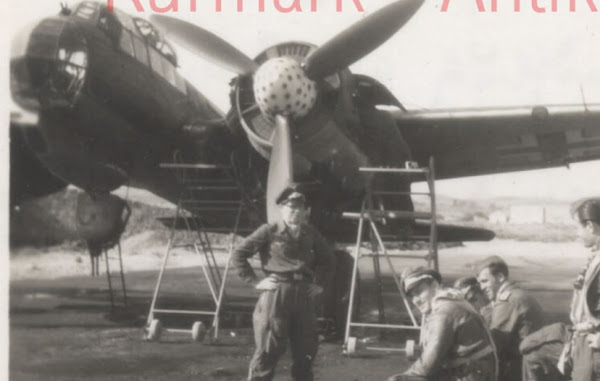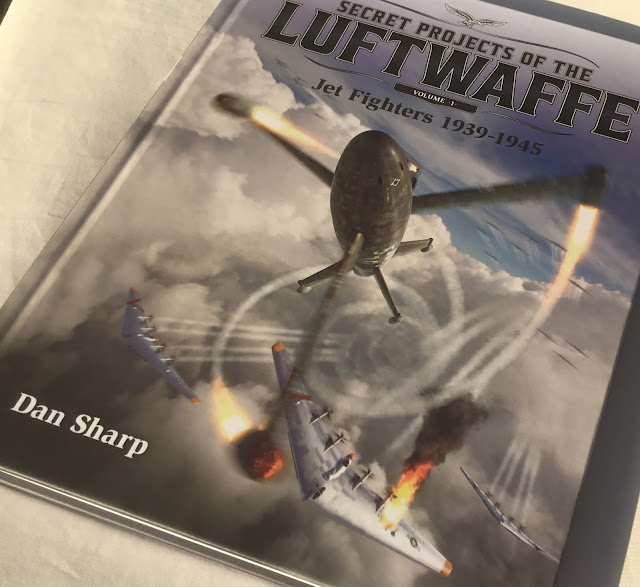Aufklärungsgruppe Ju 88 D1 (no sign of any underwing bomb racks) probably from 1. (F) 122 based in Greece in early 1944. According to the annotation, a 'souvenir snapshot taken prior to our Feindflug (combat sortie) of March 25, 1944 which ended in a crash landing'. Interesting spinner decoration....and fourth image below, " Athens..from 800 meters.." showing the 'effectiveness' of this dappled finish in action.
Friday, 27 November 2020
Wednesday, 25 November 2020
Bf 109 losses 1944-45 « we would have preferred the He 112 to the Me 109.. »
In a thread on ww2aircraft.net entitled " the He 112 wins the fighter contest and becomes the primary day fighter of the Luftwaffe for the period 1936-43 " I pointed out that Wolfgang Falck wrote a piece in the German fighter pilot's association magazine stating that one of the major 'failures' of the Luftwaffe was preferring the Me 109 to the He 112.
I added, "..as everyone knows thousands of Bf 109s were lost in accidents.." The OP responded "..thousands, really?. "
I assumed that most enthusiasts are aware of the huge losses of Bf 109s. A discussion on Me 109 losses can be found in Peter Schmoll's " Me 109 Produktion und Einsatz " (MZ Buchverlag, 2017) . There is, for example, on pages 191-193 a full break down of Me 109 losses for 1944 and 1945 headed " Totale Verluste, Durch- Ohne Feindeinwirkung" ( Total losses through- and without enemy intervention). So for the month of December 1944 alone, Me 109 losses 'ohne Feindeinwirkung' (ie 'accidents') total 570. This is more or less the monthly figure for Bf 109 accidents for EVERY SINGLE MONTH through 1944. Although accidents in October and November 1944 were not quite so high - ‘just’ 400 Me 109s lost through accidents in each of these two months. The figures quoted above don't include damaged or combat losses - these were of a similar order of magnitude. So that effectively means around one thousand Me 109s were being written off monthly from January 1944 to April 1945. Production and service deliveries only barely kept up with losses..
So, yes, thousands of Me 109s were lost in accidents, primarily because the aircraft was 'tricky' to take off and land, especially for inexperienced pilots. The Bf 109 was a small, high-powered fighter that was difficult to take off and land because of torque, narrow-track gear, poor visibility, narrow-cramped cockpit, high-wing loading etc etc..My point being many 'thousands' of Bf 109s losses were 'avoidable' as Falck said when arguing that the Jagdwaffe may have been better off putting the He 112 into service rather than the Me 109. Falck’s 8. Staffel of the Jagdgeschwader Richthofen briefly flew the type in 1938..
« .. the He 112 was an excellent aircraft ..much easier for inexperienced pilots to fly and with its low, wide track undercarriage far less prone to ground-looping....if the decision had been left up to the airmen then undoubtedly they would have preferred the He 112 over the Bf 109...Messerschmitt must have ‘lobbied’ hard or had far better contacts to the ‘upper echelons’.... »
Falck makes the point that the He 112 had far better take-off and landing characteristics. Of course it is probably also the case that the He 112 with DB 605s of 1500+ HP, much increased torque and wing loading (due to heavy powerplant, armament and ammo, fuel and protection) would not have remained as docile as the historical He 112 Bs...
Wednesday, 18 November 2020
Heinkel He 219 night fighters due to be delivered during April 1945?
" Please note that Table F on page 39 of my He 219 book has been updated to include a 7th build block (Bauausfuhrung 7 B.A.). I'm sorry it was not originally included in the book, but this was very much a grey area at the time of publication. The attached supplement gives details of the changes which, as you'll see, affect only the last four A-0 pre-production machines from Schwechat assembly..."
Sample pages at their website here
Wednesday, 11 November 2020
Werner Petermann, ace of JG 77
The latest issue of 'Avions' magazine (No. 237) features a lengthy bio of JG 77 ace Werner Petermann written by Bernard Roland.
Below; Petermann in his 5./JG 77 Emil 'black 11' during summer 1940 in Norway. Note the II. Gruppe emblem - a stylised Sea-eagle looking out over the German Bight...
"... I was born in Thurm (between Zwickau and Chemnitz) in Saxony on October 21, 1917. Many years prior to this my father had lived and worked in the USA, only to return to Europe and Germany in 1908. I had three brothers and three sisters. One of my brothers joined the Kriegsmarine like me, was killed as a sailor in the English Channel. The second, an infantryman during the war, was seriously wounded on two occasions and subsequently died of his injuries. My youngest brother was not old enough to serve...."
Saturday, 7 November 2020
Jagdgruppe Herrmann (?) Bf 109 G-6 - ebay photo find #337
currently on offer and advertised by the seller as JG 3 in France..
Note the lower fuselage blind-landing antenna......
..and the Blendschutzliste flame damper above the exhaust stack and the whistle on the first ejector stub. Wilde Sau Bf 109s were armed with the MG 151 cannon in the wing pods as here....
Final selling price for the first image was well over 1000 euros
Thursday, 5 November 2020
Morton's editor and author Dan Sharp on his new " Secret Projects of the Luftwaffe -Jet Fighters "
I recently posted a quick over-view of a very nice hardback published by Mortons - ‘Secret Projects of the Luftwaffe - Jet Fighters 39-45' which rather failed to do justice to what is a very nice and impressive publication. As the blurb puts it, author and researcher Dan Sharp has written ' the most complete and detailed account [..]..of German WWII jet fighter development' ever compiled. In comparison my review came across as a little lacklustre no doubt. I spoke to Dan subsequently to discuss his new work. With Dan's permission here are some of his insights into German jet fighter development. His 'five-star' book is recommended reading for all Luftwaffe enthusiasts.
"...You said in your review that you thought this was a 're-published' title. It is in fact a totally new work. A vast amount of effort in researching primary source documents went into it and it is, I believe, the most comprehensive account of jet airframe development programmes in WW2 Germany ever written. The cover artwork did appear on a 'bookazine' which sold out of its very limited print run five years ago. While my book does of course describe some of the better known jet projects that were under development it goes much further. In fact I'd say I've included every single known jet design ever worked on in Germany during WW2 (and several that were unknown prior to the publication of this book). Each one is set in context, the dates given are backed up by period sources, the details of every known jet fighter requirement, specification and design competition are given. This is something no previous book has ever done..."
"..The section on the Me 163's early development supersedes that written in Ransom's Me 163 Volume 1 and indeed I'm currently helping him to update his book for a reprint, based on the new archival information that I have recovered..."
"..Similarly, my fully referenced account of the single jet fighter competition(s) supersedes those of both Forsyth and Koos, since I found all the original material they had based their versions on plus a great deal more, which altered the timeline and enabled me to provide a more accurate account of what happened and when. I believe also that I have added previously unknown details to the development history of the Me 262 as well..."
"..Taking into account the above I do feel your review of my book is selling it short somewhat. Of course I realise that wartime aircraft development is not your primary area of interest. That said if anyone feels that I have the wrong end of the stick anywhere, or if there is any area where I have clearly 'dropped a star' I would be happy to accept and acknowledge it. I would much rather know about any possible misinterpretations so that I can amend them when the opportunity arises. I know some authors will deny anything is ever wrong with their work and will defend demonstrably flawed histories to the bitter end - but I'm not that way inclined. There's always more to discover and more to learn and if you think someone else has done any of it better than me, please tell me!.."
"..I have tried to get this across in my book, with maximum use of contemporary documents to dispel any suggestion of inaccuracy or fantasy (again, certain authors in this field do not seem to be above simply making things up). If anyone can demonstrate that anything is wrong with my account - I would love to know about it so I can better understand what really happened!.."
"..Incidentally, I note from your blog that you are still reading Ron Ferguson's "He 219 An Illustrated History".. You may be aware that, in parallel, Rich Carrick and a team of authors have been working on another He 219 book which will follow Martin Pegg's revised Hs 129 book and the Forsyth/Creek Ar 234 book under the Chandos banner. .."
"..Documents on the aircraft types featured in my book are relatively few and far between, so during the course of my research I happened to scoop up vast quantities of irrelevant material to find bits and pieces on 'projects'. As part of this process, I've dredged up most of the same documents Ron Ferguson has used to build his book - and a whole lot more. I have located some 62 period documents on the He 219 (accounts of meetings on it, test centre reports, comparisons with competing designs, reports on engines for it, armament for it, proposed developments of it etc. etc.). Through the use of these documents, some of the questions Ron Ferguson leaves unanswered in his book can in fact be answered - such as the precise date of its cancellation - and some blanks can be filled in, as well as providing the colour of verbatim accounts of meetings on the He 219..."
"..My point is that even if something doesn't seem immediately relevant to the aircraft developments I might be writing about at the time, I aim to collect and absorb absolutely everything to do with every aspect of German WW2 aircraft development. It is the only way, I believe, to get a complete picture of what was happening!.."
"..I have also been helping Francis L. Marshall with updates for his Bf 109 T book - such as providing the original specification for a carrier fighter from 1935 (making the overall development programme several years longer than originally thought).It's amazing how much is still out there to be found and how uncovering this material about 'projects' can literally rewrite the history of famous in-service types!.."


















